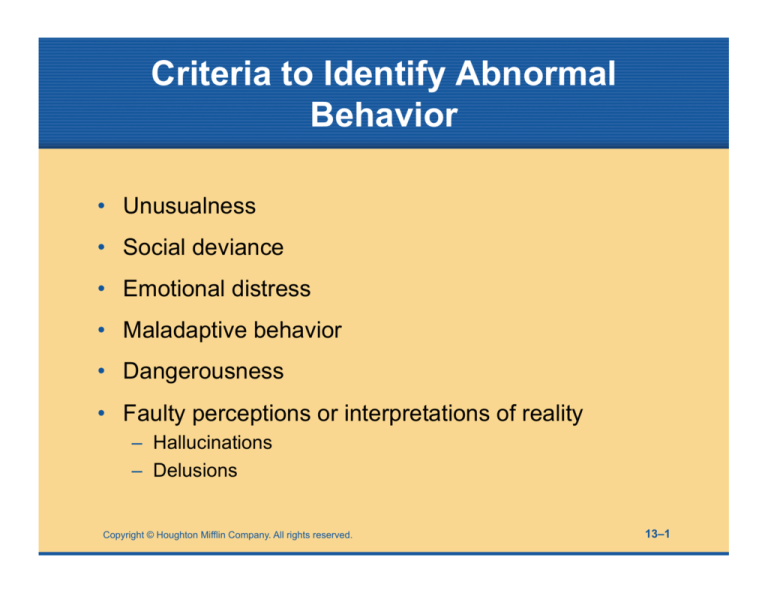
Criteria to Identify Abnormal
Behavior
• Unusualness
• Social deviance
• Emotional distress
• Maladaptive behavior
• Dangerousness
• Faulty perceptions or interpretations of reality
– Hallucinations
– Delusions
Copyright © Houghton Mifflin Company. All rights reserved.
13–1
Psychological Models of
Abnormal Behavior
• Psychodynamic model (Freud)
– Unconscious conflicts
• Behaviorist model (Pavlov)
– Role of learning
• Humanistic model (Rogers, Maslow)
– Conscious choices and self-actualization
• Cognitive theories (Ellis, Beck)
– Distorted thinking and maladaptive behavior
Copyright © Houghton Mifflin Company. All rights reserved.
13–2
How do we diagnose
psychological disorders?
• American Psychiatric Association
– Diagnostic and Statistical Manual of Mental
Disorders – 4th ed. (DSM - IV)
• Multi-axial system
– 5 axes or dimensions
Copyright © Houghton Mifflin Company. All rights reserved.
13–3
Psychodiagnosis: The
Classification of Disorders
• Axis I – Clinical Syndromes
• Axis II – Personality Disorders or Mental
Retardation
• Axis III – General Medical Conditions
• Axis IV – Psychosocial and Environmental
Problems
• Axis V – Global Assessment of Functioning
Psychological Disorders
• Distinctive patterns of abnormal behavior
– Mental disorders or illnesses
• Rates of disorders
– Rather common
– About 50% in lifetime
• Classification
– Diagnostic and Statistical Manual of Mental
Disorders (DSM-IV-TR)
Copyright © Houghton Mifflin Company. All rights reserved.
13–5
Types of Anxiety Disorders
• Phobias
– Social phobias
– Specific phobias (acrophobia, claustrophobia)
– Agoraphobia
• Panic disorder
• Generalized anxiety disorder (GAD)
• Obsessive-compulsive disorder (OCD)
Copyright © Houghton Mifflin Company. All rights reserved.
13–6
Causes of Anxiety Disorders
• Biological factors
– Disturbances in neurotransmitter functioning
– Genetic influences
• Psychological factors
– Classical and operant conditioning
– Cognitive factors
Copyright © Houghton Mifflin Company. All rights reserved.
13–7
Mood Disorders
• Severe or persistent disturbances of mood
– Limit ability to function
• Include
– Depressive disorders
– Bipolar disorders
Copyright © Houghton Mifflin Company. All rights reserved.
13–8
Depressive Disorders
• Major depressive disorder
– Depressed mood for at least two weeks
• Sadness
• Worthlessness
• Changes in sleep, appetite
• Lethargy
• Loss of interest, concentration
• Seasonal affective disorder (SAD)
• Dysthymic disorder
Copyright © Houghton Mifflin Company. All rights reserved.
13–9
Bipolar Disorders
• Bipolar disorder
– Alternate between
• Depression
• Manic episodes
– Euphoria
– Restlessness, excitement
– Reckless behavior
• Cyclothymic disorder
Copyright © Houghton Mifflin Company. All rights reserved.
13–10
Causes of Mood Disorders:
Psychological Factors
• Cognitive view
– Negative way of interpreting events
– Distorted or biased way of thinking
– Cognitive distortions, such as
• All-or-nothing thinking
• Misplaced blame
• Jumping to conclusions
• Catastrophizing
• Shouldisms
Copyright © Houghton Mifflin Company. All rights reserved.
13–11
Causes of Mood Disorders:
Biological Factors
• Chemical imbalances in brain
(neurotransmitters)
– Norepinephrine
– Serotonin
• Treatment with antidepressants
– Prozac
• Hereditary influences
Copyright © Houghton Mifflin Company. All rights reserved.
13–12
Schizophrenia
• About one of one hundred people
• Psychotic disorder
• Symptoms
– Hallucinations
– Delusions
– Thought disorder, loose associations
– Positive versus negative symptoms
Copyright © Houghton Mifflin Company. All rights reserved.
13–13
Types of Schizophrenia
• Disorganized type
– Confused behavior, incoherent speech
– Vivid, frequent hallucinations
• Catatonic type
– Bizarre movements, postures, grimaces
– Waxy flexibility
• Paranoid type
– Delusions of grandeur, persecution, jealousy
Copyright © Houghton Mifflin Company. All rights reserved.
13–14
Causes of Schizophrenia
• Genetic factors- concordance rate for identical twins.
(A quantitative statistical measurement for the
presence of a given genetic trait in both members of
a pair of twins. )
• Biochemical imbalances
– Neurotransmitter dopamine -Effects of antipsychotic drugs
• Brain abnormalities- Prefrontal cortex, limbic system
• Psychosocial influences
– Diathesis-stress model
Copyright © Houghton Mifflin Company. All rights reserved.
13–15
Personality Disorders
• Rigid patterns of behavior, personality
– Self-defeating
– Deeply ingrained maladaptive personality traits
• Various disorders (10 in DSM) including
– Narcissistic personality disorder
– Paranoid personality disorder
– Schizoid personality disorder
– Borderline personality disorder
– Antisocial personality disorder
Copyright © Houghton Mifflin Company. All rights reserved.
13–16




